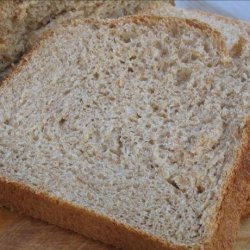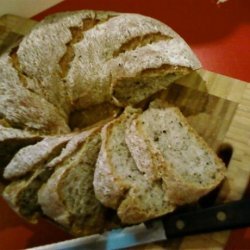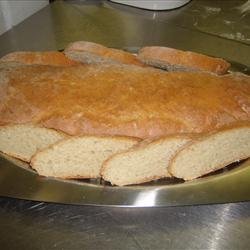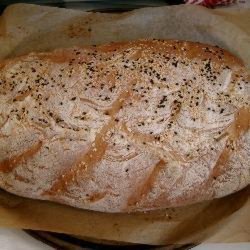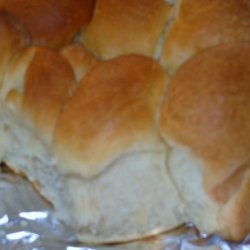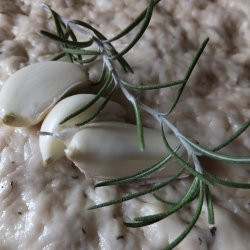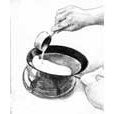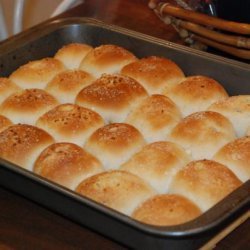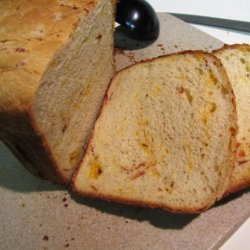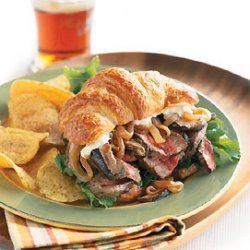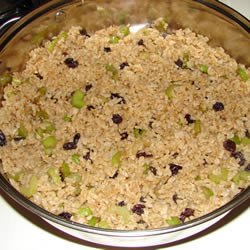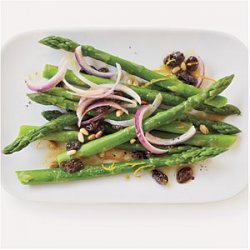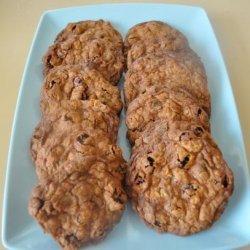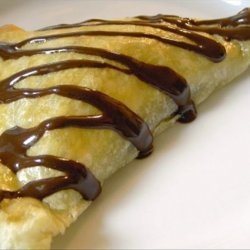Ingredients:
- equipment needed
- use a stand mixer for this recipe. most hand-held mixers will not hold
- preparation time : 24 hours
- prep time: 6 hours
- difficulty: expert
- ok now the sissy part
- i'm too lazy to do all of that.
- i make a 2# batch of bread in my bread machine. well up to the dough part. then i do the buttering and the chilling like jacques says.
- for the dough
- plus
- for the pain au chocolat
- for the pain au raisin
- almond cream , recipe follows
- hydrated raisins, recipe follows
- for the danish
- almond cream , recipe follows
- for the egg wash
Directions:
- Prepare the dough
- Melt the 3 tablespoons butter in a small saucepan over low heat. Allow the butter to cool to room temperature. It should be warm to the touch.
- In a small bowl, dissolve the yeast in the cold water.
- Place the flour, salt, sugar, milk, and melted butter in the bowl of a stand mixer fitted with the paddle attachment.
- Set the mixer on medium speed and mix just until the ingredients are dispersed, about 5 seconds.
- Add the dissolved yeast and beat on medium-high speed until the dough is well combined and no longer sticks to the sides of the bowl, about 1 minute.
- If the dough is too soft, add more flour 1 tablespoon at a time until it is firmer. (The dough is too soft when it cannot hold its shape.)
- If the dough is too hard, add cold water 1 tablespoon at a time until it has softened. (The dough is too hard when it is difficult to mix in the mixer.) Remove the dough from the mixing bowl.
- If the dough is slightly sticky and ropy, knead it with your hands for about 30 seconds, until it is smooth. Pat it into a ball. Place the dough on a lightly floured baking sheet, cover with plastic wrap, and let it proof at room temperature for about 30 minutes.
- Place the dough on a lightly floured work surface and roll it out to an 8 by 15-inch rectangle about 1/4-inch thick.
- Wrap the rectangle in plastic wrap and refrigerate for 2 hours.
- The cold retards the rising process, allowing a slow fermentation to help develop the flavor of the dough.
- Remove the dough from the refrigerator, unwrap the rectangle, and place it with a long side facing you on a lightly floured work surface.
- Spread the softened butter evenly over the right two thirds of the dough.
- Incorporate the butter by folding the (butterless) left third of the dough over the center, Then fold the right third of the dough to the left, to resemble a folded letter.
- Roll this out into another 10 by 30-inch rectangle about 1/8-inch thick. Fold each short end of the dough to the middle so they meet but do not overlap. Then fold one half over the other half and, if necessary, rotate the dough so that the seam is on your right. Wrap the folded dough in plastic wrap and let it rest in the refrigerator for a minimum of 2 hours.
- Remove the dough from the refrigerator, unwrap it, and place on a lightly floured work surface.
- Roll it into a 10 by 30-inch rectangle and turn it so a long side faces you.
- Give the dough a single fold by folding the left third of the dough over the center, then fold the right third of the dough to the left. Now the dough should resemble a folded letter. Wrap in plastic wrap and let it rest in the refrigerator for 30 minutes.
- Remove the dough from the refrigerator and place it on a lightly floured work surface.
- Roll out the dough into a 10 by 36-inch rectangle about 1/4-inch thick. Keep the thickness even and the edges straight. This will make it easier to cut the croissants or pain au chocolat.
- [/section] For croissants [/section]
- Use a sharp chefs knife to cut out triangles with a 2 112-inch base and 10-inch sides.
- Lay each triangle on a lightly floured work surface with the tip facing you.
- Gently pull the tip toward you; this light stretch adds layers to the finished croissant without adding density.
- Use the palms of your hands to roll each triangle up from the base to the tip. (At this stage, they can be frozen for up to I week if well wrapped in plastic wrap.
- Thaw on a parchment paper-covered baking sheet overnight in the refrigerator before proceeding.)
- Place the rolled croissants on a parchment covered baking sheet; spaced about 2 inches apart.
- Loosely cover the baking sheet with plastic wrap.
- Allow the croissants to proof at room temperature until they have doubled in size and appear light and full of air; about 1 to 3 hours depending on the temperature of the room and of the dough.
- For pain au chocolat
- With a sharp chefs knife, cut the dough into 3 1/2 by 4 1/2-inch rectangles.
- Lay each rectangle on a lightly floured work surface, with a long side facing you, and place about 1/2 tablespoon of the chopped chocolate in the upper third of each one.
- Fold that third of the dough over the chocolate.
- Place about another 1/2 tablespoon of the chocolate along one seam of the folded dough.
- Fold the bottom third of the dough over the chocolate. (At this stage, they can be frozen for up to 1 week if well wrapped in plastic wrap.
- Thaw on a parchment covered baking sheet overnight in the refrigerator before proceeding.)
- Turn over the pain au chocolat so the seams face down. This will keep them from opening as they bake.
- Place them on a parchment covered baking sheet; spaced about 2 inches apart. Loosely cover the baking sheet with plastic wrap and allow the pain au chocolat to proof at room temperature until they have doubled in size and appear light and full of air, about 1 1/2 to 3 hours.
- For the Pain au Raisin
- Have dough rolled to the 10 by 36-inch rectangle.
- Use an offset spatula to spread a 1/8-inch-thick layer of almond cream over the dough, spreading it all the way to the edges of the rectangle.
- Sprinkle the top of the almond cream with the hydrated raisins. Roll the dough toward you, starting at the long side. Try to keep the roll tight and even. Cut the roll into 1-inch-thick slices.
- You will have a tail on each slice. To close the pain au raisin, simply tuck the tail under the dough.
- Place the pain au raisin on a parchment covered baking sheet, spaced about 2 inches apart. Allow the Pain au Raisin to proof at room temperature until they have doubled in size and appear light and full of air; about 1 1/2 to 3 hours depending on the temperature of the room and of the dough.
- For the Danish with apricots or cherries
- Roll the dough into a 10 by 36-inch rectangle. Roll up the dough into a long cylinder that is about 2 inches in diameter. Use a sharp knife to make cut 1 1/2-inch slices and lay flat to see the spirals.
- Place on a parchment covered baking sheet.
- Allow the Danish to proof at room temperature until they have doubled in size and appear light and full of air; about 1 1/2 to 3 hours.
- Use your fingers to make an indentation/pocket in the center of the dough.
- Add a dollop of almond cream to the center of each Danish. Top with fruit (I used canned apricots halves and cherries) that have been drained on a wire rack placed over a parchment paper-covered baking sheet.
- Place the apricot half cut side down onto the almond cream. Or use 3 to 4 cherries.
- Preheat the oven to 375 degrees F.
- Make an egg wash by whisking together the egg yolks, whole egg, and milk in a small bowl until well combined. With a pastry brush, very gently coat the pastries completely with egg wash. Bake until golden brown, about 10 minutes.
- Leftovers can be stored in the freezer if well wrapped in plastic wrap for up to 2 weeks.
- Thaw at room temperature and warm in the oven before serving.
- Almond Cream
- Preparation Time: 15 minutes
- Almond cream is always baked to a spongy, cake-like texture and can be used by itself or in combination with nuts or fruits.
- The addition of starch to this recipe ensures that it will not run out of a pastry shell during the cooking process.
- [ section] Almond Cream Ingredients [/section]
- 1/2 cup plus 1 tablespoon room temperature unsalted butter
- Generous 1/2 cup granulated sugar
- Generous 1 cup almond flour
- I large egg
- Scant 1/4 cup all-purpose flour
- To Make the Almond Cream
- Place the butter, sugar, and almond flour in a medium-size mixing bowl and beat with an electric mixer set on medium speed until light and fluffy, about 5 minutes.
- The mixture will be dry and sandy until the butter begins to incorporate.
- Add the egg and mix well. Use a rubber spatula to scrape down the side of the bowl as needed.
- The egg is well incorporated when the mixture is light and creamy, about 3 minutes. It is important to allow time for this air to beat in, otherwise, the almond cream will be too heavy.
- Add the flour and beat on low speed just until it is no longer visible, about 30 seconds.
- Pour the almond cream into an airtight container and store in the refrigerator for up to 5 days.
- Allow it to come to room temperature before using and beat it lightly with an electric mixer set on medium speed until it returns to its initial volume and is once again light in texture and color.
- Yield: 1 3/4 cups
- Hydrated Raisins
- I like to use hydrated raisins in a lot of recipes. I always keep a jar of them in the refrigerator.
- The proportion 1 use for adding the liquor is about to 10 to 20 percent of the weight of the water. If you do not dilute the liquor with water, be prepared for a very strong burst of flavor.
- 1 cup raisins
- Water, as needed
- 1/2 cup dark rum or flavored liquor
- Place the raisins in a mixing bowl or glass jar and add water so that it covers the raisins by at least 1/2-inch.
- Stir in the rum or flavored alcohol. Cover with plastic wrap and place in the refrigerator for 24 hours. It is even better to allow the raisins to hydrate for 2 to 3 days.
- You can keep them in the refrigerator for a few weeks. When you are ready to use them, strain the amount that you need through a fine-mesh sieve before adding them to the recipe.
- Yield: 1 cup
Nutrition Facts
| Amount Per 1 Serving | |||
| Calories | 283.02 Kcal (1185 kJ) | ||
| Calories from fat | 135.49 Kcal | ||
| % Daily Value* | |||
| Total Fat | 15.05g | 23% | |
|---|---|---|---|
| Cholesterol | 53.77mg | 18% | |
| Sodium | 281.66mg | 12% | |
| Potassium | 76.97mg | 2% | |
| Total Carbs | 33.1g | 11% | |
| Sugars | 9.37g | 37% | |
| Dietary Fiber | 1.25g | 5% | |
| Protein | 5.24g | 10% | |
| Vitamin A | 0.1mg | 5% | |
| Iron | 3mg | 17% | |
| Calcium | 79.6mg | 8% | |
| Amount Per 100 g | |||
| Calories | 270.09 Kcal (1131 kJ) | ||
| Calories from fat | 129.3 Kcal | ||
| % Daily Value* | |||
| Total Fat | 14.37g | 23% | |
|---|---|---|---|
| Cholesterol | 51.31mg | 18% | |
| Sodium | 268.79mg | 12% | |
| Potassium | 73.46mg | 2% | |
| Total Carbs | 31.59g | 11% | |
| Sugars | 8.94g | 37% | |
| Dietary Fiber | 1.2g | 5% | |
| Protein | 5g | 10% | |
| Vitamin A | 0.1mg | 5% | |
| Iron | 2.9mg | 17% | |
| Calcium | 75.9mg | 8% | |
* Percent Daily Values are based on a 2000 calorie diet. Your daily values may be higher or lower depending on your calorie needs.
Find out how many calories should you eat.
Get Your Recipe of Health!
Follow RecipeOfHealth on Facebook!



